Do you feel like there is a complete overhaul of the SAP middleware every 3 days? Ever wondered what are the differences between XI, PI, and PO? Well, you are not alone! There have been major changes to SAP middleware XI/PI/PO in its lifetime. From the first introduction of SAP XI in 2002, SAP has completely changed the architecture with their major version upgrades.
As an integration consultant, you have to not just keep up with the new PI/PO technology and architecture changes, but be ready to deal with hundred new abbreviations that come with it. IE, IS, IR, ESR, AE, AAE, AEX, ccBPM, NWBPM?! Do not worry, I am not trying to confuse you more with these abbreviations. Not only will we compare the differences between SAP eXchange Infrastructure (XI), Process Integration (PI), and Process Orchestration (PO), but also look at different components that belong to each version. Also, we will compare new components available in SAP PO and what components have become obsolete in PI/XI versions due to the introduction of java only PO architecture.
Moreover, we will talk about the features of the SAP Integration Suite and SAP Cloud Platform Integration.
For us to understand the differences between XI, PI and PO, first, we need to look at the main functionaries of middleware,
What is Middleware:
-
Connectivity: Which protocol to use – SOAP, FTP?
-
Routing: Who are the receivers of the message – Multiple receivers? Condition-based routing?
-
Transformation: What kind of conversion or mapping is required? XML to text?
-
Runtime: messages monitoring and security
-
Workflow (BPM): How to execute a series of steps? Integration scenario with a Purchase Order approval process?
SAP has been able to cover all these areas successfully with SAP PI/PO middleware solution.
Overview of SAP Middleware Versions:
The first SAP eXchange Infrastructure (XI) was introduced in 2002 with version XI 2.0. This was a dual-stack option with ABAP and Java stacks. After a few versions of XI, SAP introduced SAP Process Integration (PI) 7.0. PI single stack only installation option was introduced with PI 7.3 in 2010. Finally, in 2011 SAP introduced PO (Process Orchestration) with version 7.31.

To understand the differences between these versions, let’s look at the major architecture changes of each.
SAP eXchange Infrastructure (XI) Architecture Overview:
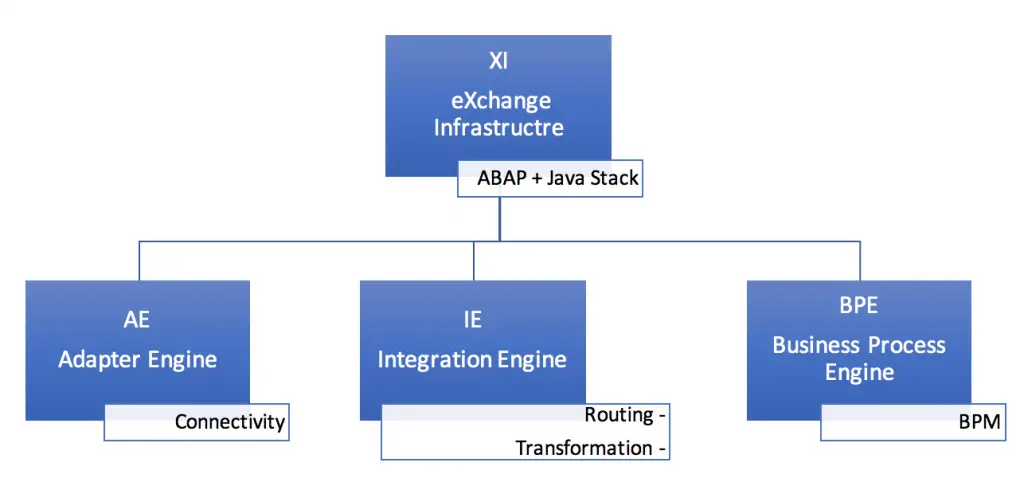
SAP eXchange Infrastructure (XI) contains Adapter Engine (AE), Integration Engine (IE), and Business Process Engine (BPE). It was installed on a dual stack Netweaver installation with ABAP and Java stacks.
-
AE – Adapter Engine
As the name suggests, the main purpose of this component was to provide connectivity functionality. Adapter engine provided capabilities of talking to different communication protocols using different adapters.
-
IE – Integration Engine
SAP XI component which was responsible for transformation and routing of the messages. Integration Engine also provided a runtime to the message communication. In XI heavy message processing was done through IE as each message was routed, transformed and executed by this component.
-
BPE – Business Process Engine
The engine which executess ccBPM (Cross Component Business Process Management) workflows. ccBPM is based on Business Process Execution Language (BPEL) and required a dual-stack installation as its runtime environment was on Web AS ABAP.
Drawbacks and Challenges with eXchange Infrastructure (XI):
One major drawback of XI is inefficient performance due to back and forth communication between components. Also due to the dual-stack architecture and multipole components, message persistence impacted the performance.
SAP Process Integration (PI) Architecture Overview:
With SAP introducing Advanced Adapter Engine (AAE), PI was able to process messages end to end without Integration Engine (IE) runtime. This reduced the cross-communication between components and improved performance massively.
-
AAE – Advanced Adapter Engine
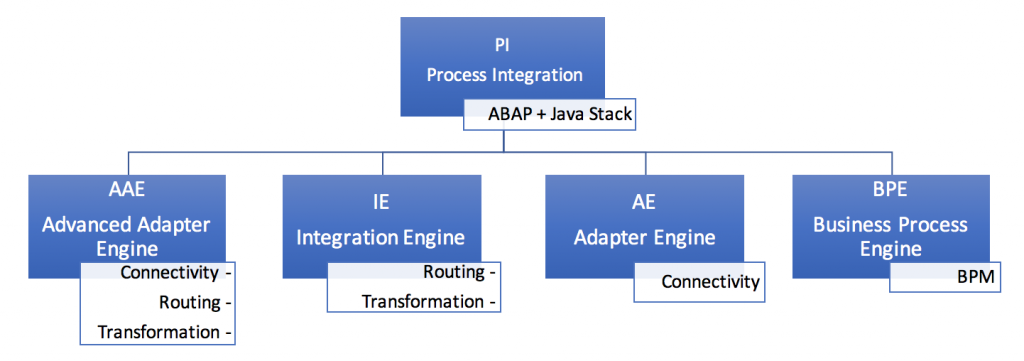
AAE has capabilities to handle routing, transformation, and connectivity which were segregated into different components in SAP XI. Integration Configuration Object (ICO) was introduced for design time instead of traditional XI objects such as sender agreement, receiver determination, and receiver agreement. ICO made it possible to connect, transform and route messages in AAE without Integration Engine (IE) runtime. Also, dual-stack message persistence was eliminated since ICO scenarios were executed independently by AS Java.
Drawbacks and Challenges of PI with AAE
Although PI installation with AAE enhanced performance in comparison with XI, still improvements were needed to extend connectivity and performance. AAE could only handle a limited set of connections and still required IE runtime for development and administrative purposes. Plus, the RNIF adapter and the CIDX were not available in AAE. Also, earlier versions of AAE did not include iDoc and HTTP adapters since they belonged to the ABAP stack. Moreover, BPE still required ABAP stack for runtime as it was ccBPM. As you notice, although performance was improved compared to XI, SAP couldn’t completely decouple the need for Integration Engine (IE).
-
B2B Add-on
B2B add-on was also introduced to PI with versions PI 7.1. B2B comes with a set of B2B protocol adapters, converter modules, and B2B infrastructure services for serving the EDI integration needs of most industries.
-
AEX -Advanced Adapter Engine Extended
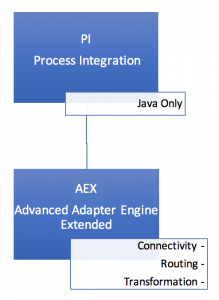
Finally, with SAP PI 7.30 version SAP eliminated the need for Integration Engine (IE) and introduced the Advanced Adapter Extended (AEX). AEX is a single-engine which includes Enterprise Service Bus (ESB), Integration Directory (ID), and AAE capabilities. With AEX, PI became a Java AS-only installation and SAP completely decoupled the ABAP stack. Also with PI 7.3 SAP introduced the iDoc_AAE adapter and http_AAE which run on Java. The complete removal of the ABAP stack is a major change in the SAP PI architecture.
Drawbacks and Challenges of PI with AEX
Although PI with AEX improved performances by completely decoupling the ABAP stack and the need for Integration Engine (IE), it did not include Business Process Management (BPM) capabilities.
SAP Process Orchestration (PO) Architecture Overview:
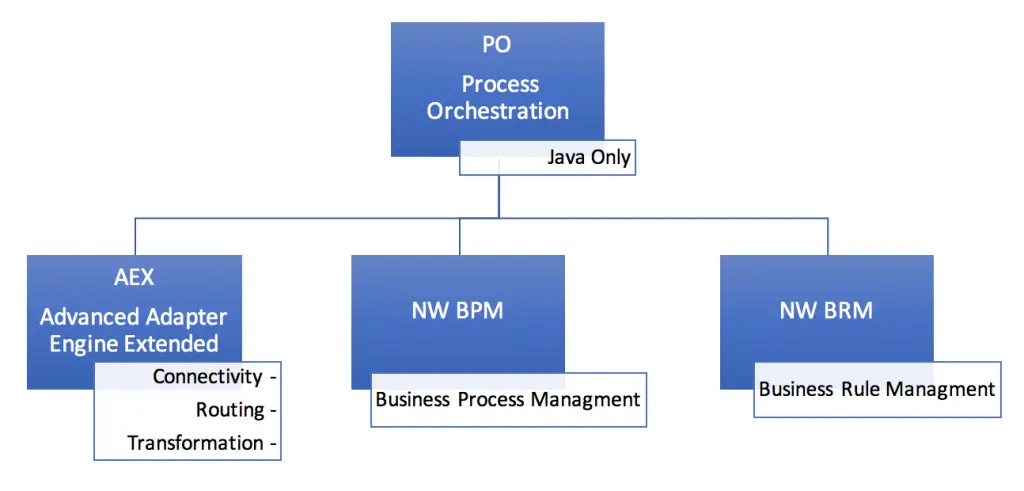
To overcome all these challenges with PI, SAP released Process Orchestration which was a Java-only installation. Yes! No ABAP stack installation was available from PO 7.31. Plus, with the new PO version SAP has added fully functional Netweaver Business Process Management (NW BPM) and Business Rule Management (BRM) which were fully executable on Java. Therefore, Process Orchestration (PO) is a combination of Process Integration (PI) with AEX, Business Process Management (BPM), and Business Rule Management (BRM) which only runs on Java.
-
NW BPM – Netweaver Business Process Management
Unlike ccPBM, NW BPM runs on a Java-based environment called CE (Composite Environment). Also, NW BPM uses Business Process Model Notation (BPMN) language while ccBPM uses Business Process Execution Language (BPEL). Although ccBPM design time was on ABAP stack, you require Eclipse-based tool NWDS (Netweaver Development Studio) for NW BPM. Even if you have extensive experience in ccBPM, you need to start learning NW BPM from scratch.
-
BRM – Business Rule Management
Business Rule Management (BRM) contains modeling capabilities targeting business analysts. Rules are owned by LoB, not by IT.
What is SAP Integration Suite and Cloud Platform Integration (CPI)
SAP Integration Suite was formally known as SAP Cloud Platform Integration Suite (CPI). SAP Integration Suite is the Integration-Platform-as-a-Service offering from SAP. Organizations can acquire SAP Integration Suite features on a subscription basis. Since the integration platform services can be accessed via the internet, it greatly reduces the initial implementation costs for hardware and IT resources.
Following are the main features of SAP Integration Suite;
- Cloud Integration
- Open Connectors
- API Management
- Event Mesh
- Integration Advisor
SAP Integration suite (CPI) is not a newer version of SAP PO. It is a new integration platform provided by SAP to address cloud-based integration requirements.
Cloud Integration
Cloud Integration feature provides a platform to build, deploy, and manage end-to-end integration scenarios in cloud-to-cloud, cloud-to-on-premise, and on-premise-to-on-premise domains.
Additionally, SAP has provided more than 2000+ prebuilt integration flows on A2A, B2B, and B2G processors that can be deployed with the minimum development effort.
Open Connectors
The open connector capability of the SAP Integration Suite standardizes the connectivity to third-party cloud applications. SAP has provided more than 160+ pre-built connectors to none-SAP cloud applications such as Shopify, ADP, SalesCloud, Workday, etc. Developers can easily reuse these prebuilt connectors to establish connections to third-party cloud applications. You can find a full list of open connectors here.
API Management
API Management is the feature that provides a platform to build, analyze, publish and monetize APIs.
Event Mesh
The event mesh makes use of event-driven architecture for integration. This greatly reduces having to have peer-to-peer connections. Organizations have the option to publish their business events in a data lake or data queue for multiple data receivers to consume.
You can read more details of SAP Integration Suite in the linked article. Moreover, we are written an article that discusses what to consider when migrating from SAP PI/PO to CPI.
Summary:
To conclude, SAP PO contains all the functionalities of PI, plus BPM and BRM in a single Java stack. I hope you were able to visualize the evolution of SAP middleware. By looking at the history of changes to SAP middleware architecture from XI to PI to PO, you can see the reasoning behind these changes.
Additionally, we discussed the features of SAP Integration Suite and CPI.
If you have any more questions comment below!
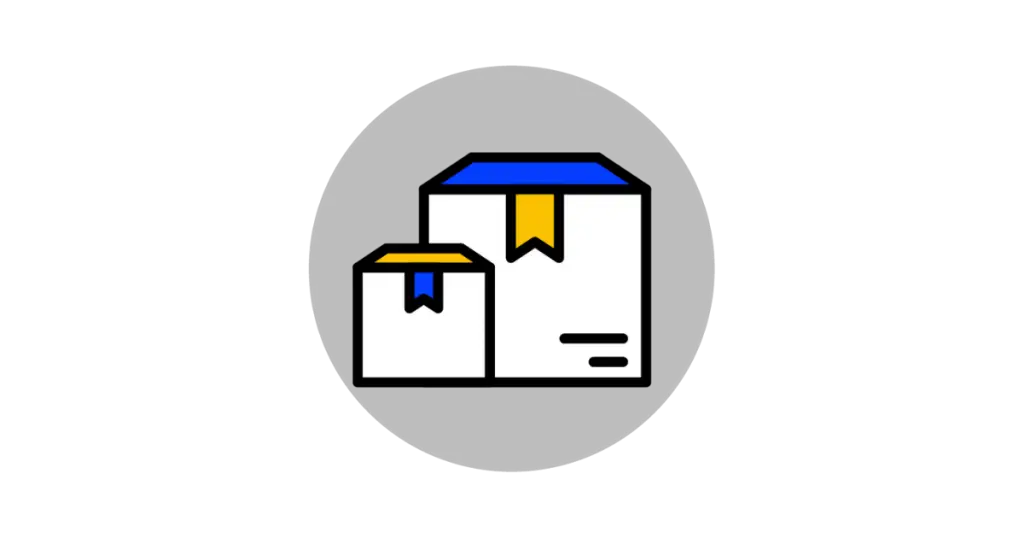
Hi Fernando,
In 7.31 we can see sxmb_moni in ECC. Though is is just sap transaction code, it is showing the PI messages. So was sxmb_moni is part of JAVA or ABAP? Can you please share your knowledge on sxmb_moni.
Hi Samantha,
SXMB_MONI is used to monitor and reprocess XML messages in the local Integration Engine. How you monitor messages processed in the Integration Engine in ECC or ABAP stack is through SXMB_MONI. You configure it using transaction SXMB_ADM.
Hi Fernando,
Thanks for your reply.Can you please answer below one.
1.In 7.31 which is single stack, how can we have abap stack (sxmb_moni)..do you mean sxmb_moni is only for ecc and not belongs to PI at all?if so can you please say what is local integrtion engine and its uses.
In dual stack Sxmb_moni t code uses for the ecc or abap stack.To find messages are processing or not in integration engine level. In 7.31po single stack runs java stack only so there is no need to use sxmb_Moni t.code.
SXMB_MONI is available in all SAP ABAP stacks like ECC, AFS, S4 HANA etc , not just in PI ABAP stack of dual stack PI. Even if PI is a single java stack version, if you have a ABAP backend system, SXMB_MONI can be used to monitor messages in backend system.
We are migrating to SAP PO. We have a middleware EDI translator and need to convert the flat file IDOC to and XML IDOC for PO. Is it now possible for PO to di this? Both inbound to SAP PO and out of SAP PO to the middleware?
Hi Ed,
There are several options to handle EDI messages in SAP PO. You can either use B2B Integration Cockpit which comes as an add-on. With B2B cockpit you might be able to scrap the use of EDI translator and use the cockpit as the translator. It handles multiple EDI formats such as X12, EDIFACT etc.
Or you can keep the EDI translator and use SAP PO for pass through or receiver determination (rule based routing).
Check my blog post on how to install B2B Cockpit.
Cheers!
Isuru
Hi Isuru,
Very simple and nice content with so much of information.
Excepting few more blogs.
Please share SAP CPI knowledge as well.
Regards,
Pavan
Thank you Pavan!
Nice article
Thank you Madhavi!
Wow. this is an Amzing artcile for freshers to get an idea and exprerinced to brush up their ideas. Thanks a lot
Thank you Indumathi!
Hi Indumathi,
Thank you very much! Don’t forget to subscribe to my email list 🙂
Cheers!
I have many years of ABAP experience, but I have never had to use SAP PO until now.
On my current assignment I need to change an existing interface.
What transaction do I use to view an interface; and which transaction do I use to change an interface?
Is it SXMB_MONI to view an interface and SXMB_ADM to change an interface?
The main change I need to make is add a field.
Hello Densil Green,
In order to view existing interfaces you need access to SAP PI/PO. Which version of PI/PO do you use? Usually, you access existing interfaces using Java Swing Clients or NWDS. This totally depend on the version you are using and your interface development procedures of your organization. So first get access to PI/PO clients. Then you can change the interface message format from Enterprise Service Repository. SXMB_MONI is a transaction where we can monitor Proxy interfaces. SXMB_ADM is a admin cockpit for interface configuration. They are ECC transactions and you cannot use them to change interface (add/remove fields). Interface message structure and mapping can be changed only from SAP PI/PO clients. if your scenario is a proxy interface, when you change the interface in PI/PO proxy should be regenerated in ECC side using SPROXY. When the proxy is regenerated, proxy class will include the new fields you added to the interface. After this step, you can implement the ABAP logic for the new field in the proxy class. Hopefully this helps!
Cheers!
Hi Fernando,
Great article!,
i wanted to know what changes can a user with SAP_ALL profile make to the data that is routing through SAP PI and is the data closed from amendments .If the data cannot be amended during the routing process?, how is it protected from modification?
Can a user with SAP_ALL access change the interface routes resulting in the messages going in different directions
Hello Mathias,
Thank you!
In PI users cannot edit message payload and reprocess them. But user can use “copy’ function in the message monitor to duplicate messages. That is another message can be created from a message. Also, Using PI test tool users can process messages manually. Using this test tool, users can directly copy the payload and process them. You need to make sure only super users or authorized users have access to these options in production environment.
Hope this explanation will be helpful!
Cheers!
Isuru
Hi Mr. Isuru Fernando,
I am new in ABAP and i have got the task to coordinate and suggest PI upgrade strategy to BASIS team of my organization. The senior resource has developed all scenarios way back since 2013, and some in 2015. There are some scenarios running in SAP PI, I got the understanding that SAP NW running is 7.4 and SAP PI is running 7.0 whose End of Maintenance was 2017. My organization wants to upgrade it to the version (But No SAP PO) so that End of Maintenance could be extended to a maximum date. Now I want to understand
1. What i need to do to check whether all scenarios are built on single stack or in different stacks. How to identify them.
2. Can I do something like export all objects/ scenarios and simply import into new fresh installed SAP PI version?
Hello Zia,
There are several ways to migrate interfaces from dual stack to single stack. This is a broader discussion, please send me a mail to [email protected] with more detail.
Cheers!
Isuru
Hi Isuru,
can u arrange a training session for the person who are like to learn SAP PI/ PO.
Hi Isuru,
Really a good blog. Basically I am SAP Portal consultant and i want to convert to PI/PO consultant. your blogs are explained very well and easy to understand the difference of PI/PO advanced features.
I would like to hear from you about the difference of HCI & CPI..both are same? or any functional difference are there?
Regards,
Dharmaraj
[email protected]
Hello Dharmaraj,
Thank you! 🙂
Products HCI and CPI essentially provide the same functionality. SAP has rebranded HCI (HANA Cloud Integration) as CPI (Cloud Platform Integration). SAP HANA Cloud Integration is now called SAP Cloud Integration.
Cheers!
Isuru
Thank you for this awesome article! Totally beneficial for someone who are not from SAP XI/PI background.
Thank you Hadi!
Hi Isuru,
I am still confused between PI and PO. Please help to clarify my down…
I have worked on PI (AEX) where I downloaded NWDS and connected it to my AEX server then developed some NWBPM scenarios, deployed it and they were running successfully…
What exactly difference between PI (AEX) and PO….. Please help to understand it.
– Rashmi
Hello Rashmi,
Check more on SAP Process Orchestration here.
Cheers!
Isuru
Hi Fernando ,
Unbelievable Information and easy explanation. Its making me feel like “that’s it!”.
Thank you.
Thank you, Syed! I appreciate your support!
Hi Isuru,
Great explanation, complex things explained in simple way.
Its time to enhance this blog and include CPI capabilities as well. It would be great for audience to understand the SAP Integration in cloud with On premise comparison.
– Sangam
Hello Sangam,
Thank you very much!
Cheers!
Isuru
Very nice article Isuru.
I have attended a few training sessions for PI/PO on the Basis side and I can co-relate the stuff you have mentioned here.
That’s kind of you to say Kishore! Thank you!
for practical knowldge where I have to go through for sap po plzz do reply
Hi Lucky,
Please contact me via [email protected].
Cheers!
Isuru
Hello Isuru,
Really good read, thanks.
Is there a more details technical discussion of the same?
For example, in Dual stack we’ve Receiver Determination , Interface Determination, Sender Agreement & Receiver Agreement which is converted to ICO in Single stack. What happens if I am migrating my system from dual stack to single stack ?
I am sure ESR would still remain the same which means there should be a way to directly export and import ESR objects from Dual to single stack ?
Happy to connect directly in case if this is too much outside discussion.
Thanks,
Nishanth
Wonderful article. Thanks for sharing.
Thank you for the support Arun!
Easy and classy Explanation. Went through many blogs about differences in PI version, this is the best one. Thanks for sharing
Thank you very much, Amith!!
Hello Isuru
The articles which you are published are really helpful for the beginners like me. They are simple and anyone can easily understandable. I would like you thank you for sharing your knowledge which leads to help so many professionals like me.
Once again thanks a lot
Regards
Jai
Hello Isuru,
Really good read, thanks.
Is there a more details technical discussion of the same?
For example, in Dual stack we’ve Receiver Determination , Interface Determination, Sender Agreement & Receiver Agreement which is converted to ICO in Single stack. What happens if I am migrating my system from dual stack to single stack ?
I am sure ESR would still remain the same which means there should be a way to directly export and import ESR objects from Dual to single stack ?
Hello Isuru,
I have gone throught it all the blog,still, I have doubt regarding in my scenario we are at sap pi 7.4 NetWeaver versoin and we want to update NetWeaver 7.5 for we need to update license pi to po ?
Hi Thanks Isuru for a great explanation of the PI/PO journey.
Hello, today we have implemented a PI dual stack 7.5, should it be taken to PO? to CPI? Or what would be the next step?
Thanks a lot
you made it sooo simple and cooool… great explanation… thanks for all your content… keep going…